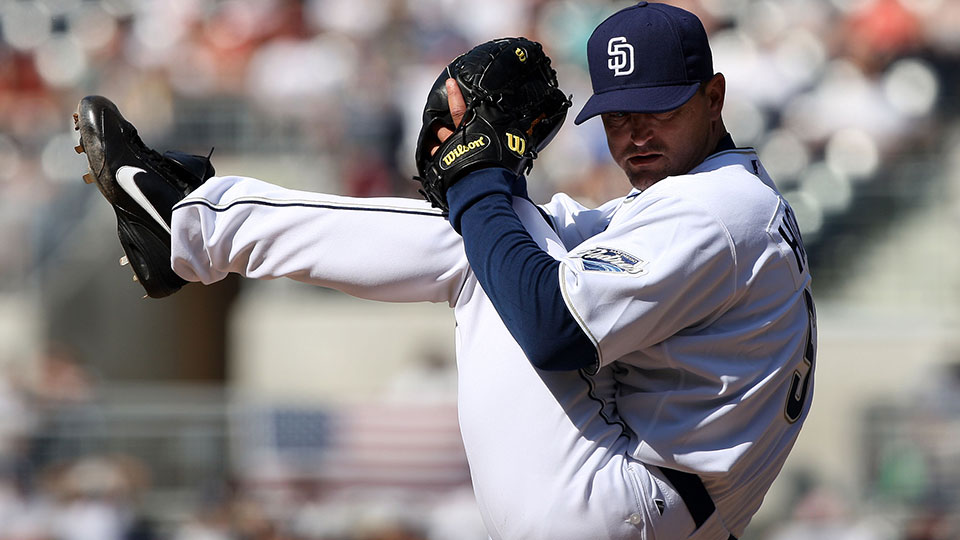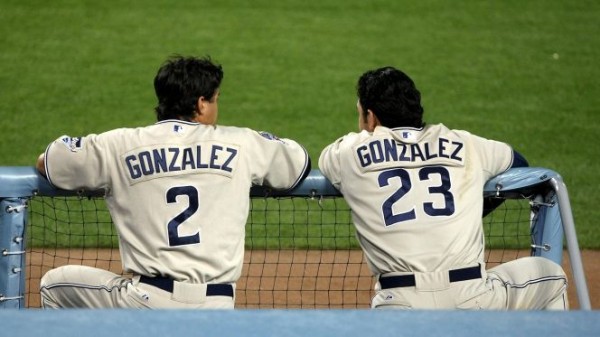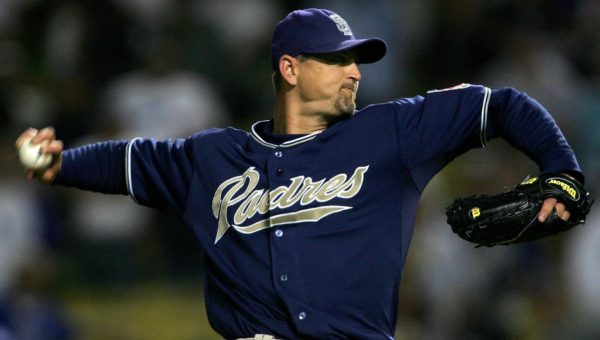The Five Worst and Best Trades in Padres History

Credit: AP Photo

Best
5. January 6, 2006: Traded Akinori Otsuka, Billy Killian, and Adam Eaton to the Texas Rangers for Adrian Gonzalez, Terrmel Sledge and Chris Young.
The Padres were coming off of an NL West division title and a playoff appearance and were looking to bolster their already strong team. To replace the departed Phil Nevin, the Padres traded for a promising young slugger, Adrian Gonzalez. In the deal, they sent one of their best relievers from the 2005 season, Akinori Otsuka (3.59 ERA, 108 ERA+) and six-year starter Adam Eaton to Texas along with minor leaguer Billy Killian, who never made it to the big leagues.
Otsuka pitched two years for the Rangers and his 2006 season was stellar with a 2.11 ERA and 220 ERA+ in 68 games. He did not pitch again after the 2007 season. Eaton pitched just one year with Texas, posting a forgettable 5.12 ERA with a 90 ERA+. He signed with the Phillies after that season and ended up pitching four seasons after being dealt by San Diego, but accumulated -3.1 WAR.
San Diego made off like bandits in this deal. Gonzalez quickly became a franchise cornerstone, hitting 24 homers and batting .304 in 156 games in 2006, his initial year with the club. His numbers would only get better from there, as he hit at least 30 home runs in the next four seasons including 40 in 2009, becoming only the fourth Padres player to hit 40 homers in a season and no one has done it since. He posted an OPS+ of 126 or better each of his five seasons as the Padres’ everyday first baseman. He made three straight All-Star teams and won two Gold Gloves as a Padre and averaged 4.1 WAR per season. He finished just two home runs shy of the franchise record.
The best part was Gonzalez was not the only player in this deal that worked out for the Friars. Chris Young made an immediate impact in the starting rotation on a team that won a second straight division title in 2006. He had a 3.46 ERA in 31 starts for the Padres that year and pitched in the only playoff game the Padres won in the Division Series against the Cardinals. He even came the closest to a no-hitter the Padres have ever gotten, going 8 1/3 hitless innings against the Pirates on September 22, 2006. Better yet, he was an All-Star in 2007 with a 3.12 ERA and 128 ERA+, complementing the Padres’ dominant starting rotation led by Cy Young winner Jake Peavy. Young finished his Padres career with a solid 3.60 ERA and 110 ERA+ in 97 starts.
4. December 15, 1997: Traded Steve Hoff, Derrek Lee and Rafael Medina to the Florida Marlins for Kevin Brown.
The Padres were through fooling around after the 1997 season. They knew they had the pieces to make a run if they could add a top-of-the-rotation stud, like Kevin Brown. Brown was coming off of winning the 1997 World Series with the Florida Marlins. The Padres packaged prospects to the rebuilding Marlins for Brown’s services. Among those prospects, only Derrek Lee became anything noteworthy. He eventually won three Gold Gloves, earned two All-Star bids and was the 2005 National League batting champion for the Cubs.

Brown was a one-year rental for the Padres but that one year paid off in a big way. He led the Padres to the National League pennant with an All-Star performance. He had a 2.38 ERA with a 164 ERA+ and a major league-low 2.23 FIP as he finished third in Cy Young voting with a ridiculous 8.6 WAR. In the playoffs, Brown became even more valuable. In Game 1 of the Division Series, he out-dueled Hall of Famer Randy Johnson of the Astros in Houston, tossing eight shutout innings with 16 strikeouts. Four days later, he pitched in Game 3, allowing just one run and pitching into the seventh inning. If they handed out MVP awards for Division Series winners, Kevin Brown would have been it for the Padres. He made five starts in that postseason, helping the team make the World Series.
3. June 4, 2016: Traded James Shields with cash to the Chicago White Sox for Erik Johnson and Fernando Tatis Jr..
This one is becoming more and more laughable every day. James Shields signed a four-year, $75 million contract before the 2015 season with the Friars and it did not work out as planned. He never had an ERA+ above 95 in his season and a half with the Friars. After it came to a head in June of 2016, A.J. Preller pulled off what may eventually become the greatest heist in Padres history and perhaps one of the best (or worst, depending on who you ask) trades in all of baseball.
Fernando Tatis Jr., in just half of a season, has become the face of the San Diego Padres, a team that has faces like Eric Hosmer and Manny Machado. Tatis has been the best, most consistent player on the team the entire season. He has gone from unheralded teenage prospect to the second-best prospect in all of baseball, to now, what Mike Trout calls, the most exciting player in the entire league. He has 3.6 WAR, a .339 batting average, and 1.021 OPS in his first 58 major league games, simply astounding. The Padres nor its fans have ever seen anything quite like Tatis don Padres’ threads. He is must-see TV.
All he cost was an overpaid, washed-up pitcher well into his 30s.
2. December 28, 1994: Traded Derek Bell with Doug Brocail, Ricky Gutierrez, Pedro Martinez, Phil Plantier and Craig Shipley to the Houston Astros for a player to be named later, Ken Caminiti, Andujar Cedeno, Steve Finley, Roberto Petagine and Brian Williams.
There is a lot to flesh out here, but the bottom line is, the Padres got two franchise players out of this deal (and no they did not trade that Pedro Martinez). The Padres dealt away Derek Bell, who become a good player for Houston, posting a 5.4-WAR season in 1998 with 22 home runs and a .314 average, while batting .281 in his five years as an Astro. Brocail struggled in Houston and was dealt away after two subpar seasons. Gutierrez was an average big leaguer for five years there. Martinez pitched in just 25 games for the Astros before being shipped off elsewhere. Plantier and Shipley were both journeymen of sorts.

The return for the Padres was groundbreaking and franchise-altering. Ken Caminiti came in and made an immediate impact in 1995, with 26 home runs, a .302 average, and a .894 OPS, while also winning a Gold Glove at third base. Steve Finley also quickly made a name for himself with a solid ’95 season as well, with .297 average and a Gold Glove in the outfield. 1996 is when it took off for both of them. Caminiti put up video game numbers (40 HR, 130 RBI, .326 avg, 1.028 OPS, 7.6 WAR), becoming one of only two Padres (Tony Gwynn, 1994) to finish a season with an OPS of at least 1.000, on his way to the National League MVP award, a Silver Slugger and another Gold Glove. Meanwhile, Finley exploded for 30 home runs, a career-high at that time, while he also won a second consecutive Gold Glove. These two helped the Padres win their division that season.
The best accomplishment by these two franchise players is, of course, guiding the 1998 Padres to a World Series appearance. Caminiti hit 29 bombs while Finley manned a solid outfield. They provided the leadership necessary to get San Diego into their second-ever World Series. They both played four seasons for the Padres. Caminiti finished with a career .924 OPS while Finley hit 82 home runs and won two Gold Gloves.
1. June 24, 1993: Traded Gary Sheffield, Rich Rodriguez to the Florida Marlins for Andres Berumen, Trevor Hoffman, and Jose Martinez.
Gary Sheffield was certainly a great player in his own right. Had it not been for the Hall of Fame haul San Diego received, this might be viewed as one of the worst trades in franchise history, but luckily, it turned out much differently thanks to one minor league shortstop. In 1992, Sheffield was an All-Star, a Silver Slugger winner and finished third in MVP voting with 33 home runs, 100 RBI and a batting title with a .330 average for the Padres. He would eventually hit 509 home runs and be a nine-time All-Star. Like the situation with Adrian Gonzalez, the Padres new there would be a hefty price to keep Sheffield in San Diego. They got the Marlins to take on his salary in exchange for a host of minor leaguers, one of them being Trevor Hoffman, who had just converted into being a pitcher in the Marlins system.

Hoffman appeared in 39 games for the Friars after the midseason trade, with a 4.31 ERA and 96 ERA+. By 1996, he had established himself as one of the best closers in the game, saving 42 games that season with a stingy 2.25 ERA in 70 games, posting a 3.8 WAR. 1998 of course, was one of the best seasons by any closer, as he set the National League record with 53 saves with a microscopic 1.48 ERA, helping the Padres reach the World Series. He had a 2.08 ERA in three games in the NLCS that year.
Hoffman finished his Padres career with 552 saves, and now with 601, has the most all-time for a National League closer. He was the first closer to reach both 500 and 600 saves. He is the Padres’ all-time leader in WAR for a pitcher with 26 and ERA at 2.76 and was named an All-Star seven times. Everything was iconic about Trevor Hoffman, from the high leg kick to the nasty changeup, to the electric entrance to the tune of Hell’s Bells. Hoffman rode that to Cooperstown where he wears a Padres cap and is one of five Padres to have their number retired.
Not bad for a salary dump.
Native of Escondido, CA. Lived in San Diego area for 20 years. Padres fan since childhood (mid-90s). I have been writing since 2014. I currently live near Seattle, WA and am married to a Seattle sports girl. I wore #19 on my high school baseball team for Tony Gwynn. I am a stats and sports history nerd. I attended BYU on the Idaho campus. I also love Star Wars.
Anybody that doesn’t have George Hendrick going to St. Louis for Eric Rasmussen on the list doesn’t know much Padres’ history.
Templeton was good, but giving up Ozzie Smith? Tempy will only see the HOF if he buys a ticket, Ozzie is royalty, one of the top 10 of all time.
When Ozzie was traded by the Padres, he was all field / no hit in his three seasons here.
No mention of the Wil Myers trade? Trea Turner, Jake Bauers, and Joe Ross! Can you imagine Trea Turner AND Tatis up the middle, or on the left side, and at the top of the line-up?! Now were stuck with having to (soon) pay a player millions of dollars not to play for the team, a player for which the Padres gave up so much (Bauers and Ross are still very young, and still developing, and TT is already an all-star shortstop with power and speed).
No mention of the Grandal trade for Matt Kemp!? That, too, was brutal because of what was given up, and what was received (a cancerous player who they struggled to give and away and still are still paying out millions of dollars for, for Joe Wieland, Yasmani Grandal, and Zach Eflin).
What about the Kimbrell trade?! Extremely high value player at the time. Other relievers were receiving incredible value in trades (Miller; Giles; Chapman; etc), and the Padres got … nothing (sorry, while it is still early, Logan Allen is not going to be of much value). This is eerily similar to the Gonzales trade (same team, 4 players received, nothing of value).
You mean the Joe Ross that followed in the family footsteps and already missed one season to injury. The Joe Ross that is a whole 3 WAR in 69 games n 290 inn w career mark of 17 and 17? The Jake Bauer’s that’s had 2 chance at playing near 100 games and can’t muster even league average production with a 25% SO rate. Even Trea has had one exceptional rookie season and the rest have been a league ave offensive player who will steal you 40 bases.
Hindsite is always 20 20 and yes Washington got the better end but not sure it’s a top 5 worst. The extension was the problem and they should have waited one more year and seen Wil for what he is. He would be gone at the end of this season. It’s not like they didn’t get Jose Castillo, and if the can develope Gerardo Reyes into something even better. Even Jeff Luhnow let Josh Hader, JD Martinez, and Ramon Laureano in his miss category.
It’s not easy to disagree with one of my favorite writers on this site, but I do here…especially on the McGriff-Alomar trade being the worst in team history.
To preface, I would not have traded Robbie Alomar, as he was 22 and a star in the making. That said, the Padres got a great return for him and Joe Carter in SS Tony Fernandez and 1B Fred McGriff. Getting Fernandez was crucial, as Templeton was aging, and there wasn’t a replacement on the horizon. Tony’s hitting was a vast improvement over “Tempy’s,” and McGriff was one of the most consistent power hitters of his generation, slamming 30-plus homers eight times in his career.
When they had McGriff and Fernandez in their lineup (1991-92), the Padres were a good team, and just a key piece or two away from being real contenders.
The only reason why this gets labeled a bad trade is because less than two years later, Padres management had a fire-sale, and pawned off McGriff, Fernandez, and others for basically peanuts.For McGriff, they got three guys who never panned out, and for Fernandez, they acquired Wally Whitehurst (yup, Wally Whitehurst). It’s these trades — especially McGriff’s — that deserve to be ranked among the worst trades ever in Padres history.
I appreciate the input, Greg! That was a tough one to quantify for sure. I hold it a bit heavier because we gave Toronto two cornerstones in their early 90s dynasty. Of course, McGriff was a great player and I should have mentioned how he was dealt for very little, much like how the Padres handled Rizzo.
Greg, you and I are on a small list who don’t think this was as bad a trade as it’s made out to be. At the time we needed a shortstop badly and Fernandez was an all star ( even with us).